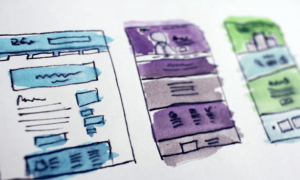Table of Contents
In the world of UI/UX design, there are a number of myths that have been circulated for years and continue to be believed by many people in the industry. However, as we move further into the future, it’s important to forget these myths and focus on creating designs that are truly effective and user-friendly. In this blog post, we will explore some of the most common UI/UX design myths and discuss why they should be forgotten in 2022.
-
The myth that users won’t give effort to reading text on screen longer than necessary
How many times have you heard someone say that users won’t give effort to reading text on screen longer than necessary? If you’re a UI/UX designer, chances are you’ve heard it a lot. And it’s no surprise why this myth persists – after all, we live in a world where people are constantly bombarded with information and scrolling through their feeds.
However, the reality is that users will read text on screen if it is well-written and relevant to them. In fact, studies have shown that people will actually spend more time reading online content if it is well-organized and easy to navigate. So, next time someone tells you that users won’t read text on screen, just smile and politely tell them that they’re wrong.
2. The myth of the one-size-fits-all solution
Another myth you should forget about immediately: the myth of the one-size-fits-all solution. This myth suggests that there is a single perfect solution for every design problem, and that all you need to do is find it. However, the reality is that there is no such thing as a perfect solution.
Every design problem is unique, and what works for one situation may not work for another. The key is to be flexible and adaptable, and to always be open to new ideas. By forgetting about the myth of the one-size-fits-all solution, you’ll be better equipped to handle whatever challenges come your way.
3. The myth of users who don’t care about design
This myth goes back to the thinking that as long as a product is functional, users will be happy. The logic goes like this: users just want to get their task done, and they don’t care about pretty graphics or fancy animation. This may have been true at one point, but it’s definitely not the case anymore.

In today’s world, users have higher expectations for design than ever before. In fact, users are increasingly expectant of both function and beauty from the products they use. A study by Google found that more than half of users (61%) are not going to return to a mobile app they had difficulty accessing and a staggering 40% are quite likely to go to a competitor’s website instead.
Another study found that 94% of people cited bad design as the reason why they didn’t trust a website. These studies make it clear that good design is essential for keeping users happy and engaged. Clearly, design matters to users. So if you’re still operating under the belief that design is unimportant, it’s time to forget about that myth and start giving users the experience they deserve.
4. The myth of designers who can do it all
Designers are often lauded for their ability to wear many hats. They’re creative, they’re technical, they’re left-brained and right-brained. But is it really possible for one person to be good at all aspects of design? The answer, in most cases, is no.
There are simply too many skills required for UI/UX design to be mastered by one person. And while it’s true that some designers may have a broader range of skills than others, it’s important to remember that no designer can do it all.
The best way to illustrate this point is with a few examples. Take responsive design, for instance. Responsive design is a complex process that requires both an understanding of how users interact with different devices and a keen eye for detail. It’s not something that can be done half-heartedly; it requires a dedication to the craft that few designers possess.
Then there’s typography. Typography is an essential part of any design, but creating beautiful typefaces is a skill that takes years to master. The same can be said for color theory and layout. These are just a few examples of the many facets of design that require specialist knowledge and expertise.
So next time you’re looking for a designer, don’t expect them to be a jack-of-all-trades. Instead, look for someone who has a deep understanding of the specific area of design that you need help with. Chances are, they’ll be able to provide better results than a generalist who is trying to do everything at once.
5. The myth that all websites should have an About Us page
One of the most enduring UI/UX design myths is that all websites must have an About Us page. The reasoning goes that potential customers want to learn more about the company before doing business with them, and an About Us page is the perfect way to provide that information.
However, user experience studies have shown that this is not always the case. In fact, in many instances, an About Us page can actually hinder conversions by distracting users from the task at hand. So if you’re designing a website, don’t feel like you need to include an About Us page just for the sake of it. Instead, focus on creating a user-friendly experience that will help your visitors achieve their goals.
Also Read This: Steps to Follow to Build a Successful Healthcare App
6. The myth of following trends over developing your own style
It is common knowledge that you need to be constantly monitoring what’s new and popular in the world of design in order to succeed. However, this thinking is based on a fundamental misunderstanding of how trends work. Trends only become popular because they solve a specific problem or address a specific need.
As such, blindly following trends is a surefire recipe for disaster. Rather than trying to copy what others are doing, user experience designers should focus on developing their own unique style. By solving problems in their own unique way, they’ll not only be able to create better user experiences, but they’ll also be able to develop a style that is uniquely their own.
There are plenty of great UX designers out there who have developed their own signature style. Take a look at any of their portfolios and you’ll see that their work is instantly recognizable. This isn’t because they’ve copied what others are doing; it’s because they’ve focused on developing their own unique approach to design. So if you’re looking to stand out from the crowd, forget about following trends and focus on developing your own style.
7. The myth of ignoring feedback from users
User experience design is all about making sure that users have a positive experience when using a product or service. Part of creating a great user experience is getting feedback from users and incorporating their feedback into the design. However, some people believe that user feedback should be ignored, especially if it conflicts with the designer’s vision.
This is a dangerous myth that can lead to poor user experiences. The reality is that designers should always be open to user feedback and willing to adjust their designs accordingly. After all, user experience is all about putting users first.











